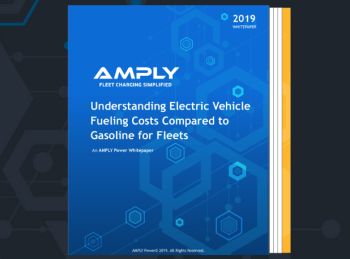
Whitepaper uses new Dollar Per Gallon-equivalent rating (DPGe) to directly compare electric and traditional fleet vehicle fueling costs
A recent white paper by AMPLY Power reveals that 25 of America’s largest metropolitan areas could save an average of 37 percent on fuel costs by electrifying their bus and light-duty vehicle fleets. Additionally, well-managed electric fleets, that optimize electricity charging for off-peak hours, and avoid demand charges, can save as much as 60 percent on fueling versus their internal combustion engine (ICE) or unmanaged EV fleet counterparts.
Publicly compiled data was used by AMPLY to develop a new Dollar per Gallon equivalent rating (DPGe). The new metric gives fleet owners, operators, municipalities, and policymakers a direct apples-to-apples comparison between gasoline or diesel fuel and electricity pricing. The research is detailed online in a new white paper and online DPGe Comparison Map, which offers a current electric-to-gasoline price comparison data for America’s 25 largest cities.
“The cost-savings for commercial electrification are real and tangible. Until now, the entire electrification ecosystem, from utilities and regulators to fleet operators, has lacked a standard metric to showcase this economic value,” said Carla Peterman, former commissioner of the California Public Utilities Commission, and current advisor to AMPLY. “Alongside proving the economic benefits found in fleet electrification, the innovation of the dollar per gallon-equivalent metric provides stakeholders the clarity to assess, plan, and budget for electric fleet transition and accelerate the industry beyond the pilot phase to full deployment.”
In the study, AMPLY Power assessed the DPGe for the top 25 U.S. metropolitan areas and identified significant commercial and regulatory implications of fleet electrification. For instance, electric bus fleets achieve significantly lower fuel costs by switching from ICE to electric, with managed charging, in all 25 of the largest U.S. cities. Portland, Oregon leads these savings with 82 percent savings by making the switch, followed by Tampa, Florida at 79 percent, and Seattle, Washington at 78 percent. Even Detroit, Michigan with the highest DPGe for city bus fleets, yields 12 percent fuel savings.
Similarly, light-duty EV fleets can also realize a lower fuel cost transitioning from internal combustion engine (ICE) fleet vehicles to electric in 19 of the top 25 U.S. cities. Portland, Oregon leads this segment again at 69 percent savings, followed by Seattle, Washington at 63 percent, and San Francisco/Oakland, California at 62 percent.
“When state-mandated programs serve as the basis for fleet electrification discussions, it’s easy for fleet professionals to start from a focus of sustainability, rather than targeting the repeatedly proven economic and business advantages of electric fleets,” said Vic Shao, founder, and CEO of AMPLY Power. “Optimizing fleet electrification programs to maximize fuel savings still requires planning and due diligence based on a fleet’s location and other factors. While this may seem complex, we challenge fleet operators to embrace these intricacies, and realize the real economic value in switching to electric.”
The Methodology of the DPGe Metric
The DPGe compares the electric dollar per gallon-equivalent of gasoline (or diesel) for specific cities. Used as a forecasting tool for EV charging, the DPGe incorporates regional-specific electricity rate structures, fleet-specific charging strategies, and vehicle class efficiencies into a single, comprehensible metric that can be used to assess, plan, and budget for an EV fleet transition. The analysis seeks to simplify complex energy rate structures and electric vehicle efficiency metrics into a single figure that Americans know and use daily—the dollar per gallon of gasoline. Due to the complexity of electricity rate structures and vehicle fleet requirements, AMPLY has provided a range for this DPGe figure.
The research details the difference between operating a fleet without managing the EV charging or having a suboptimal charging strategy that doesn’t take advantage of all the options available, and a managed fleet using an optimized charging strategy. A managed strategy takes into account factors such as peak-pricing, utility demand charges, and time-of-use rates to determine the most cost-effective charging schedule. Conversely, an unmanaged strategy does not optimize charging for pricing.
“Savings realized from EVs can easily be torpedoed if a fleet is charging at peak rates, or charging activities trigger demand charges,” said Simon Lonsdale head of sales and strategy at AMPLY Power. “For instance, in New York City, it could be more costly to transition a light-duty fleet without a managed charging strategy. However, with management, a transition could yield almost 20 percent savings. This finding illustrates both the opportunity and the risks associated with fleet electrification, and why managed charging is vital to ensuring the full economic benefits.”
Studies continue to show complex infrastructure, and confusing metrics impede electric vehicle (EV) fleet adoption. AMPLY’s Charging-as-a-Service (CaaS) business model removes these risks and complexities related to the charging logistics of electric fleet operations in exchange for predictable pricing and a guarantee that vehicles are charged fully at the start of each workday.
Further details on the DPGe metric and price comparisons can be found in the new white paper Understanding Electric Vehicle Fleet Fueling Costs through the DPGe Metric and at the real-time, DPGe Comparison Map. Data sources for the white paper include the U.S. Department of Transportation and the American Automobile Association.
About AMPLY Power
FLEET CHARGING, SIMPLIFIED. AMPLY Power provides Charging-as-a-Service to de-risk and accelerate the adoption of electric buses, trucks, and passenger vehicles by public and private fleets through its simple price-per-mile-driven model. AMPLY provides a fully managed charging solution that enables municipal and commercial fleets to deploy electric vehicles confidently and without hassles. AMPLY handles all aspects of charging operations on behalf of fleet owners and AMPLY’s charging systems are optimized for the lowest electricity costs. The company is funded by Congruent Ventures and Obvious Ventures.
The post Analysis: Top 25 Cities Could Save On Average 37% of Fuel Costs by Switching to EVs appeared first on Fleet Management Weekly.
from Fleet Management Weekly http://bit.ly/2VgtiPH



Sourced by Quik DMV - CADMV fleet registration services. Renew your registration online in only 10 minutes. No DMV visits, no lines, no phone mazes, and no appointments needed. Visit Quik, Click, Pay & Print your registration from home or any local print shop.

No comments:
Post a Comment